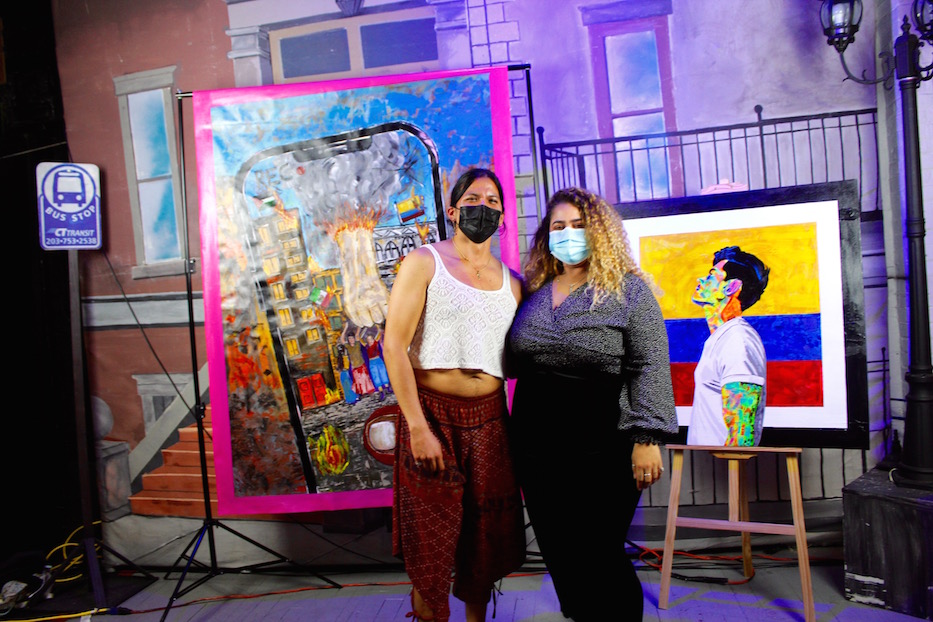
Bregamos Community Theater | Fair Haven | Arts & Culture | Visual Arts | Mutual aid | Arts & Anti-racism | Semilla Collective
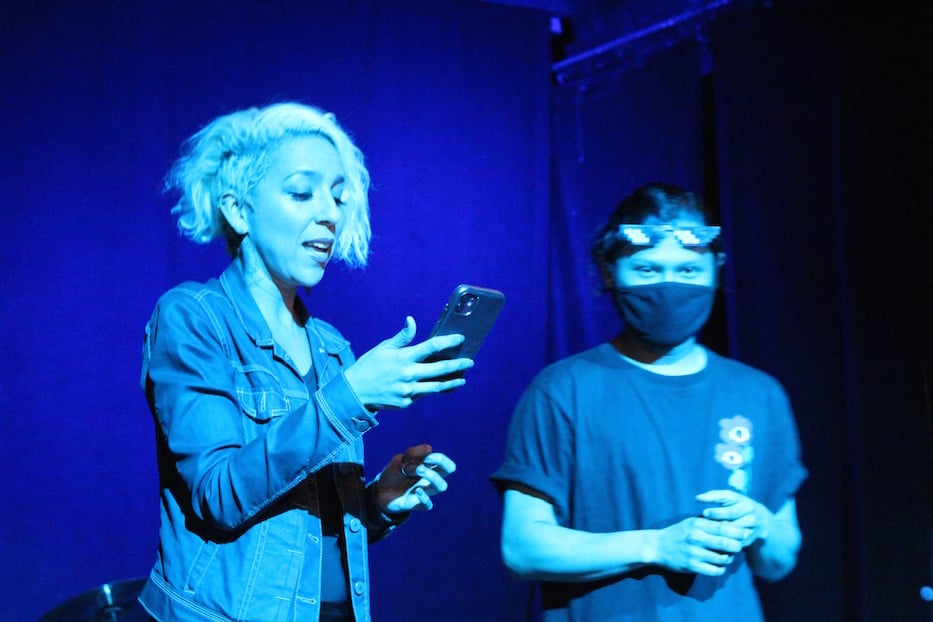
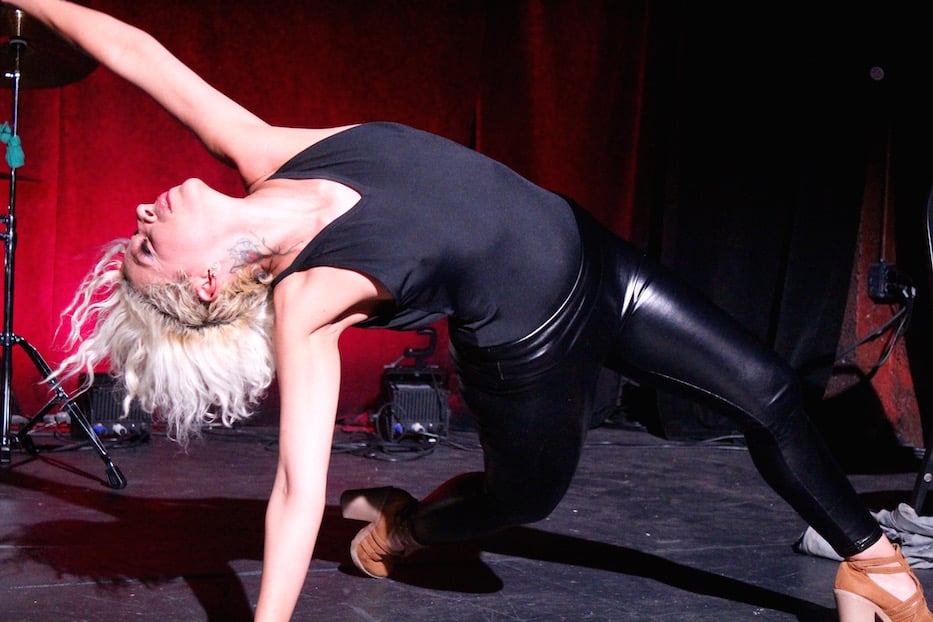
Top: Norma Leal and Javier Villatoro. Bottom: Leal mid-performance. Lucy Gellman Photos.
Norma Leal started with her back to the audience, muscles stiff beneath a denim jacket. The light shifted, and bathed her in a vertiginous blue-green. She swiveled. Her eyes blazed, cutting through the audience to the back of the theater. She cocked her head, as if she had heard a whisper somewhere in the front rows.
“Sorry?” she said. The silence around her was thick. She walked up to the front of the stage, her heels hard on the stage. “Freedom? Free? What’s free to me? Oh, what’s free to me?”
Saturday night, Leal’s performance was part of the inaugural Festival de la Resistencia, a day-long arts festival from the Semilla Collective in solidarity with Colombia and Palestine. Held at Bregamos Community Theater in the city’s Fair Haven neighborhood, the event brought together artists, activists, prison abolitionists, culinary alchemists and student organizers for over nine hours of exhibition and performance.
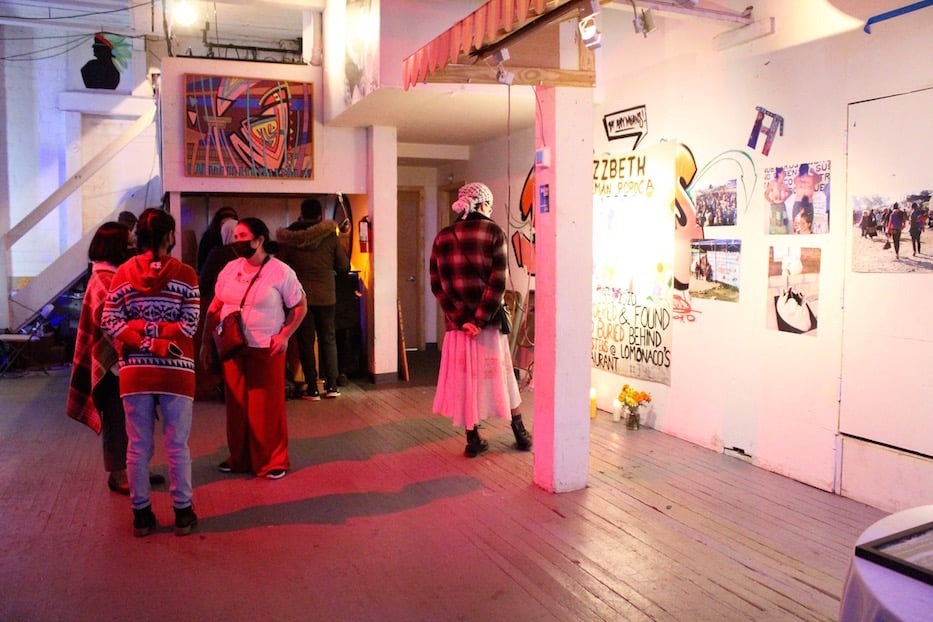
In part, it was meant to pick up the conversation where a rally in late May left off. Five months ago, hundreds of protesters gathered downtown to object to human rights abuses in both Palestine and Colombia, including the use of military force against thousands of protesters in Colombia’s major cities, and Israeli airstrikes that left over 200 Palestinians dead, many of them children, between mid and late May.
“It [the rally] was a lot of energy and love and solidarity that surged for one day,” said Camila Güiza-Chavez, a member of Semilla who organized the event with Leal. “We were thinking about how to continue that work.”
Saturday, the answer began in the theater’s Blatchley Avenue parking lot and followed attendees inside, where the walls teemed with art and low stage lights made the space glow blue and purple. Outside, families milled around a long table strung with twinkling lights, where members of Tortilleria Semilla handed out warm, homemade tortillas with cheese, avocado, and crackly pork skins. Last year, the culinary collective came out of the pandemic, as Semilla grew its mutual aid footprint across the city.
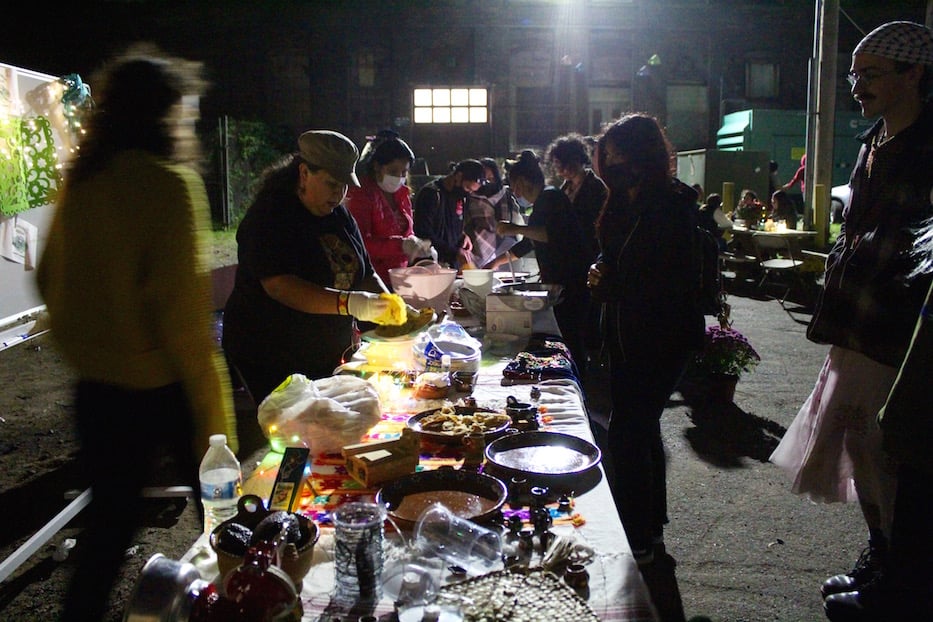
The tortilleria, which was part of the Food Business Accelerator by CitySeed and Collab, makes its tortillas through the Aztec and Maya tradition of nixtamalization from Pre-Columbian times. The result is a tortilla that blooms with deep, complex corn flavor, warm and soft with enough heft to hold its fillings.
Elizabeth Gonzalez, who is a member of the collective, said that it has become a meaningful tool for economic empowerment in a country that has left immigrants out of federal relief programs.
“The way that I see it is like the Semilla Collective is like a large tree of many people from different countries and different cultures and projects, and that the tortilleria is one of those branches,” Gonzalez said, speaking in Spanish as Semilla’s Ariana Shapiro translated. “Since the pandemic started, we saw that as immigrants we were very isolated, and we were not able to access any of the government aid. We wanted to create jobs with dignity for ourselves.”
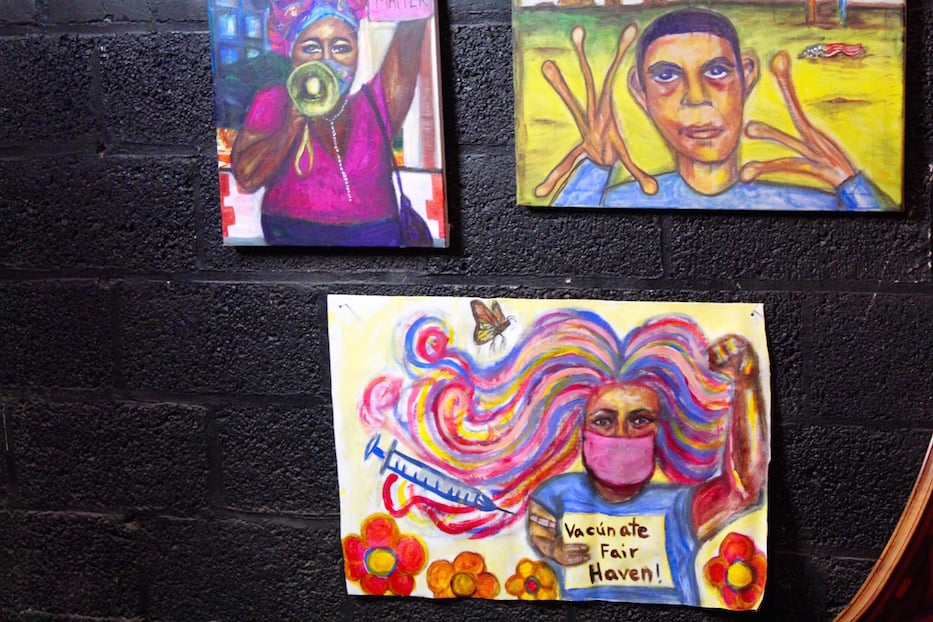
Work by artist Anthony Barroso.
Nearby, attendees studied the shapes and text on a three-part “Apartheid Wall”—the name that many organizers have given to Israel’s 400-mile barrier along the West Bank—painted in solidarity with Palestine. In the center panel, an olive tree filled the frame with huge, thick green branches heavy with fruit. The words “To exist/Is to resist” sprawled in cursive below.
Layla Maloof, a member of Yalies 4 Palestine who is studying women, gender and sexuality studies at the university, later said that the tree is a symbol of both Palestinians’ relationship with the land and, in its survival against the elements, of its peoples’ resistance. On both sides, poetry and imagery of Jerusalem peeked out, reminding viewers that many Palestinians cannot return to their homes or visit their families.
Inside the theater, art pulled attendees to the walls with a nearly umbilical force. On one side of the room, works from Eric Lee Tedana and Edee Allynnah Davis, both currently incarcerated, looked out in bright color, asking attendees to come closer. On the other, artist and organizer Vanesa Suarez had installed photographs from her visits to Chiapas, Mexico, where she visited the Zapatista Army of National Liberation (Ejército Zapatista de Liberación Nacional, or ELZN) in March 2018 and again in December 2019.
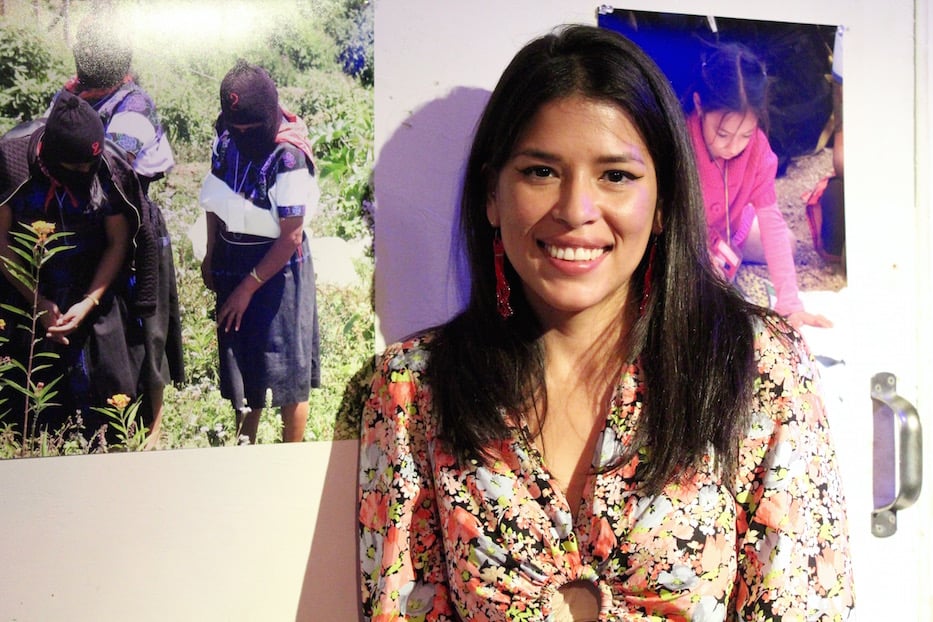
Vanesa Suarez, who has documented two gatherings of the Zapatista Army of National Liberation/Ejército Zapatista de Liberación Nacional.
During that second visit, she said, members of the ELZN dedicated a week of workshops, speeches, and events to building knowledge around femicide and gender-based violence. Thousands of women from around the globe gathered to speak about the violence they had experienced in their own lives. Suarez was able to go with Hazel Mencos, a fellow immigrant organizer in New Haven. She recalled sitting in a space with thousands of women, listening to their stories for over a day.
“We just spent hours from the day we got there to the day we left, sharing and grieving anything that we had been holding,” she recalled Saturday. Over a year and a global pandemic later, the images are still fresh in her mind.
She said they have also taken on a different context in the past 18 months. Just months after she and Mencos returned to the U.S., the two learned about Lizzbeth Alemán-Popoca, a 27-year-old mother, immigrant, and Indigenous woman in East Haven who was killed by her common-law husband in early July of last year. For months, as police did not make any arrests in the case, Suarez organized, mourned, and supported Alemán-Popoca’s family.
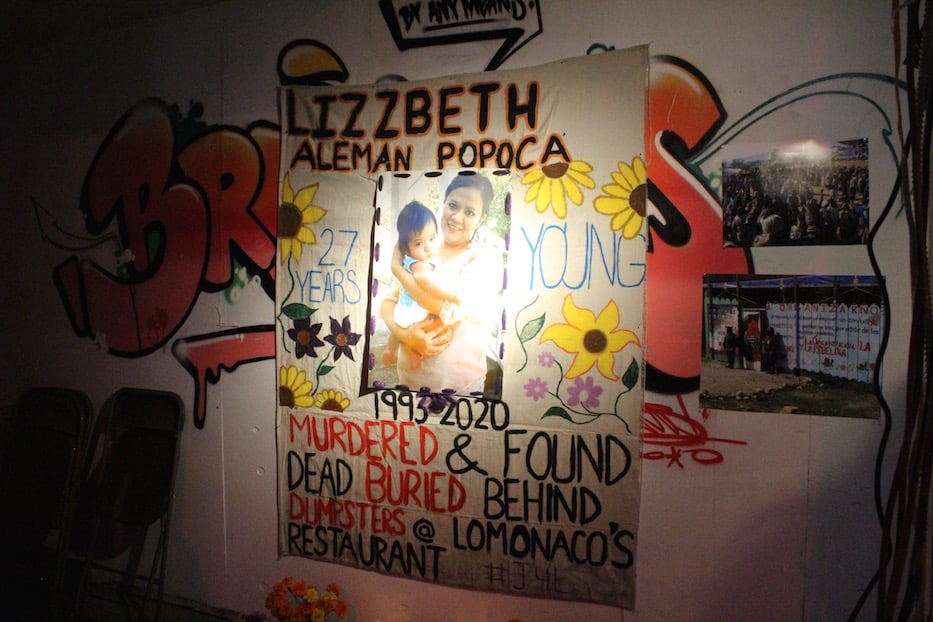
Suarez has been vocal about the case of Alemán-Popoca, who went missing and was later found behind a dumpster, since her disappearance last year. “We have to be able to talk about it,” she said of femicide in New Haven, in Connecticut, and across the country.
At rallies, she harnessed her grief to speak about the prevalence of partner violence and femicide in the U.S., including in New Haven and Connecticut. In particular, she has spoken openly about how much more common it is for Black, Latinx and Indigenous women to go missing than their white counterparts—and how comparatively little their cases are covered. Candles flickered on a memorial to Alemán-Popoca just a few feet away.
“We have to be able to talk about it,” Suarez said. “Often with survivors or families of survivors, they’re left to hold their pain and their grief alone. I see an absence of conversation around it. I think through art, that allows us to have some of the conversation. How do we do this? What does it look like in our communities?”
Because of the pandemic and a lack of resources, the 2019 photos have lived on her computer for over a year. Last month, she was awarded a grant from the Arts Council of Greater New Haven that will allow her to print, exhibit and teach from the images. In the interest of full transparency, the Arts Paper is an arm of the Arts Council, but is editorially independent from it.
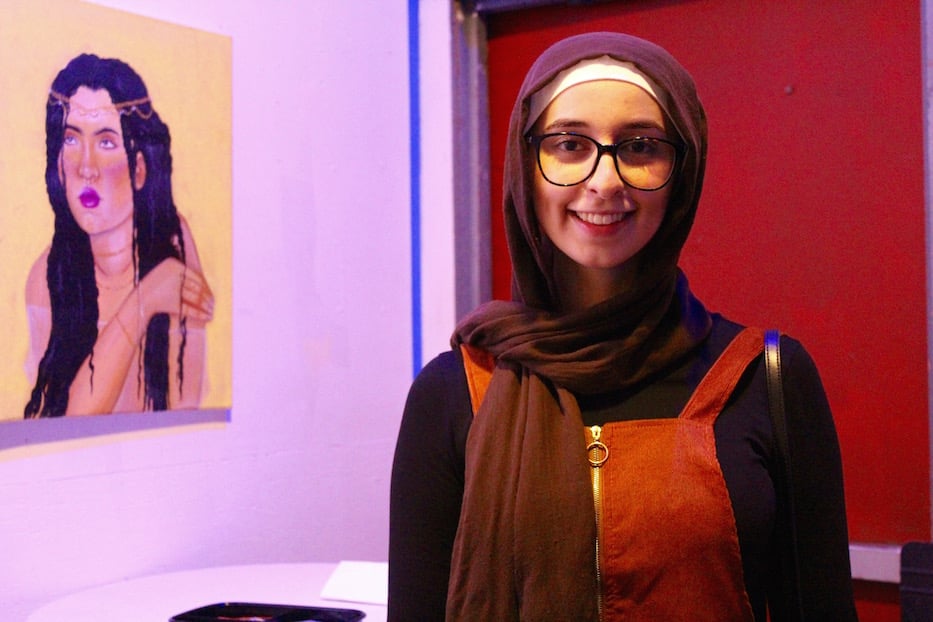
Ruqaiyah Damrah.
Nearby, Yalies 4 Palestine member Ruqaiyah Damrah studied a wall of paintings from artist Anika Stewart, who co-founded Your Queer Plant Shop earlier this year. A student in political science at Yale, Damrah helped organize the wall outside, and later spoke on Palestinian rights. To her, she said, the fight for Palestinian liberation hits close to home: her dad is Palestinian. She’s never been able to visit her extended family. She drew a through line from her own family history to “the struggles of oppressed and colonized people everywhere.”
“From the U.S.-Mexico border to India, to Saudi Arabia, to Turkey, to West Sahara and Europe, there are almost 70 walls across the world that rip through people’s lands and separate families and communities.” she later said from the stage.
Stewart stood nearby, fielding questions on her work. She jumped onboard with the show after meeting Güiza-Chavez, and feeling “absolutely in awe” of the work that Semilla was doing in the community, and wanting to learn more. Saturday, she brought works celebrating the sheer power of women, female and androgynous bodies spread out across her canvases. Across the theater, work from artist Anthony Barroso seemed to say hello, his bright figures waving across the distance. Earlier this year, Barroso was part of an effort to get more Fair Haveners vaccinated through public art on Grand Avenue.
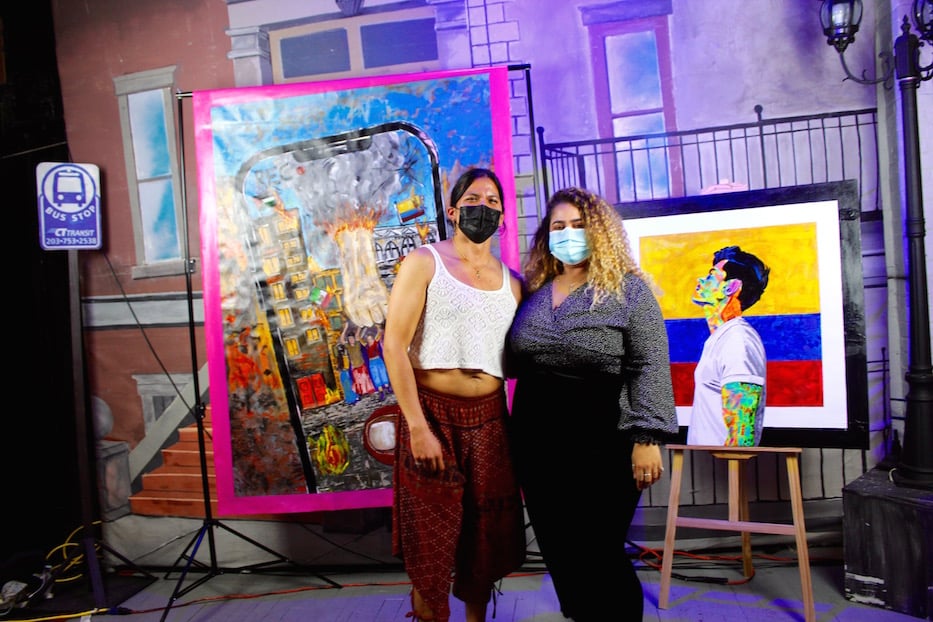
Anthony Barroso and Anika Stewart. Colombian-American artist Ricardo Gutiérrez, whose work is also on the right, worked with them on the large canvas.
With Barroso and Ricardo Gutiérrez, Stewart also worked on a huge hanging canvas in the center of the space. In the piece, rendered as a picture within a picture, a fiery hand reaches down from the heavens, flames exploding from its forearm as activists gather in the streets. Buildings burn behind them; flames lick the flags of the United States and Colombia, from which Gutiérrez hails. Beneath them, fingers wrap around a phone to press the record button.
Stewart said the work was inspired by the use of social media as a tool for documenting violence in real time, particularly for people of color. During days of Israeli airstrikes and retaliatory rocket fire from Hamas in May, she saw Palestinians using their phones in record numbers to record what was happening on platforms including Facebook, TikTok and Instagram.
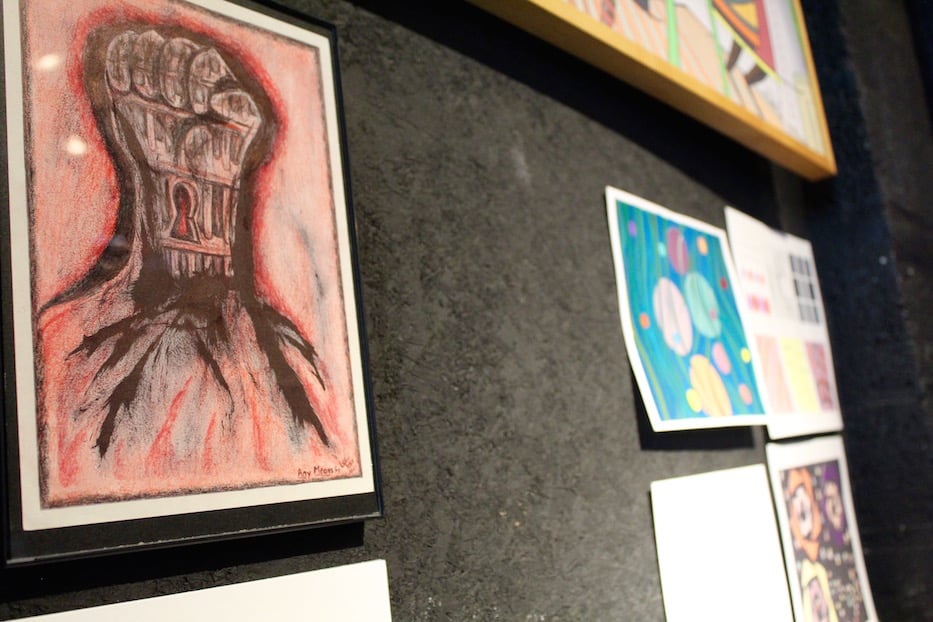
A. Ram, a graduate student at Yale, shared pieces from folks who are currently incarcerated.
It mirrored a trend she has seen in the U.S., as residents use their phones to livestream police misconduct, nationwide Karening, and both micro- and macro-aggressions in classrooms, offices, and city parks. She later brought that same verve to the stage, with poetry that built on Langston Hughes’ “Let America Be America Again.”
“While the subject matter is pretty dark and emotional, we had this beautiful time,” she said. “Always there’s this cloud of oppression and sadness.”
“It just felt intimate,” Barroso added.
On stage, that depiction of resistance took multiple forms, from drumming to dance to performance art. Playing in the last three hours of the evening, Bregamos Community Theater founder Rafael Ramos and drummer Brian Jawara Gray sat at the drums, a third musician slipping onto the stage at the last minute. As their hands began to talk to each other, attendees took their seats. Some murmured and swayed along with the music. Further back, a few continued their hushed conversations out of earshot.
No one act was similar to the next. Stewart, who lives in West Haven, worked references to the Harlem Renaissance into her present as she read about revolution, performing for the first time in front of an audience. Representing his hometown of Oaxaca, Mexico, co-emcee-turned-musician Javier Villatoro took the stage as Ene de Nadie, spinning tight rap lyrics that coasted to the back of the room.
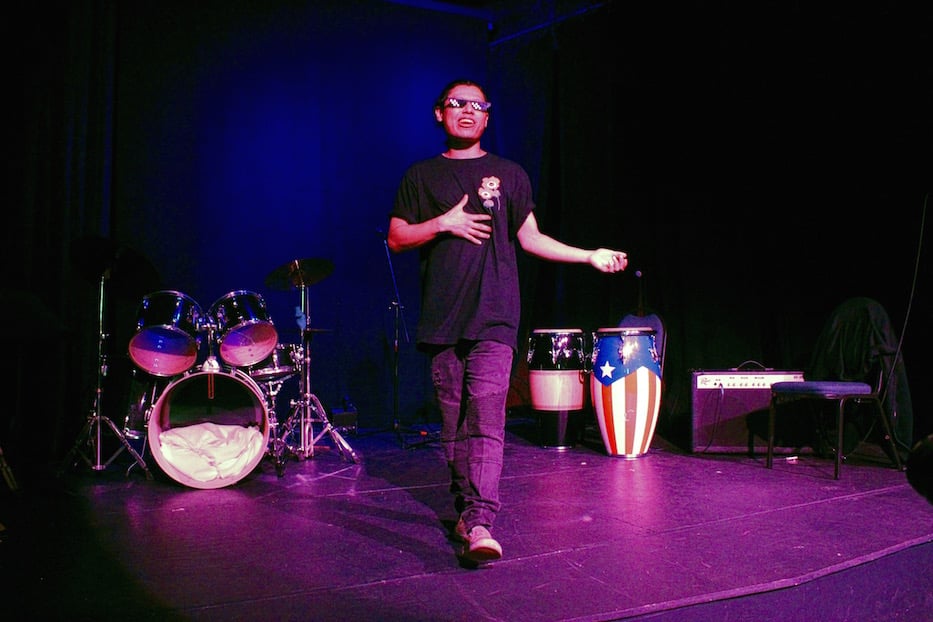
Javier Villatoro, who performs as Ene de Nadie.
After translating into English for Leal for most of the evening, he slipped back into Spanish, using the whole stage as he jumped from bar to bar with checkerboard sunglasses pulled over his eyes.
During an intermission, Villatoro said that the event was personal to him as an immigrant and Indigenous person himself. Six years ago, his family fled poverty and violence in Oaxaca and came to New Haven. He holds that history close when he hears about parallel struggles for representation around the globe, and in his adopted hometown. Even in New Haven, he said, he often thinks about who Yale might be displacing as it expands across the city.
“I come from a family of Indigenous people, and we suffered the consequences of those systems of oppression at home,” he said. “Palestinian liberation, Colombian liberation, Indigenous liberation, I see them as tied together.”
Outside, the air had turned crisp, almost wintery. Inside, applause and cheers punctuated every act. A spirit of resistance flowed From Colombia itself as members of el Colectivo de poetas y poetizas Tertulía joined via Zoom, their screen becoming the stage as they beamed from hundreds of miles away. It crackled on a track as A. Ram, a graduate student at Yale, presented work from people who are currently incarcerated in Texas.
It returned to New Haven with Güiza-Chavez and her guitarist Ismael Jamai Ait Hmitti, who conjured worker solidarity and celebrated folk tradition with covers of the Cuban artist Silvio Rodríguez. As she flowed from one song to the next, Güiza-Chavez let Rodríguez’ “La Maza” take on its own fiery current in the nooks and crannies of her voice. By two minutes into the song, she was throwing head back, hair flying through the air as she belted. Beside her, Ramos returned to the stage to play the cajón.
That momentum pulsed through both Leal’s performance and belly dancing from Kelvia Mitri-Meda, who runs the Middle Eastern Dance Academy of Connecticut in West Haven. When Mitri-Meda took the stage, a candelabra burning brightly from atop her head, the audience seemed to perk up even as the clock inched toward midnight.
As she moved, shedding layers between numbers, she got the room moving with her. When she lifted the flag on Lebanon—a nod to another country currently battling a massive humanitarian crisis—attendees cheered and made way for her to dance through a narrow center aisle. Brain Slattery, arts editor for the New Haven Independent, accepted the flag and began to wave it.
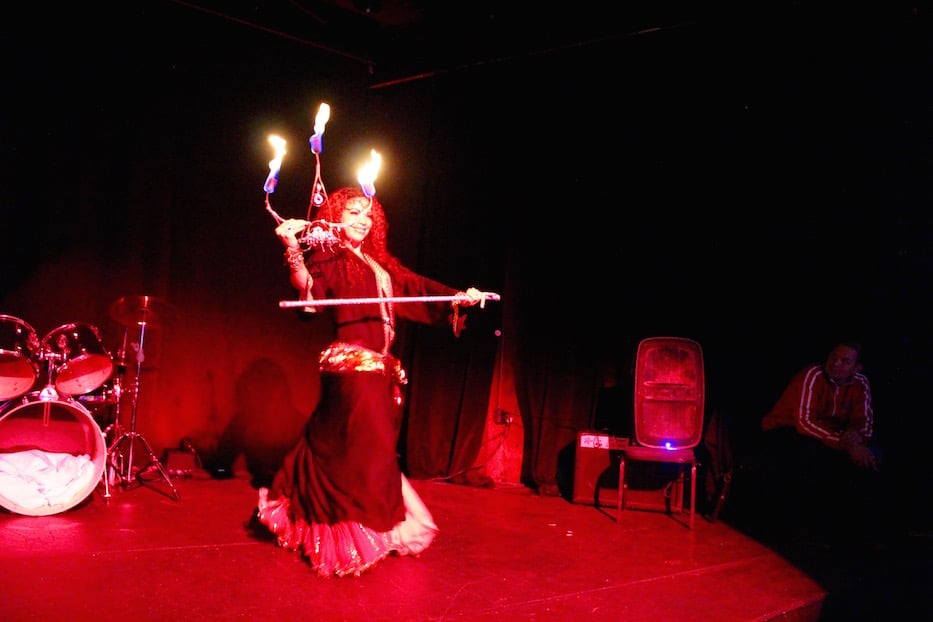
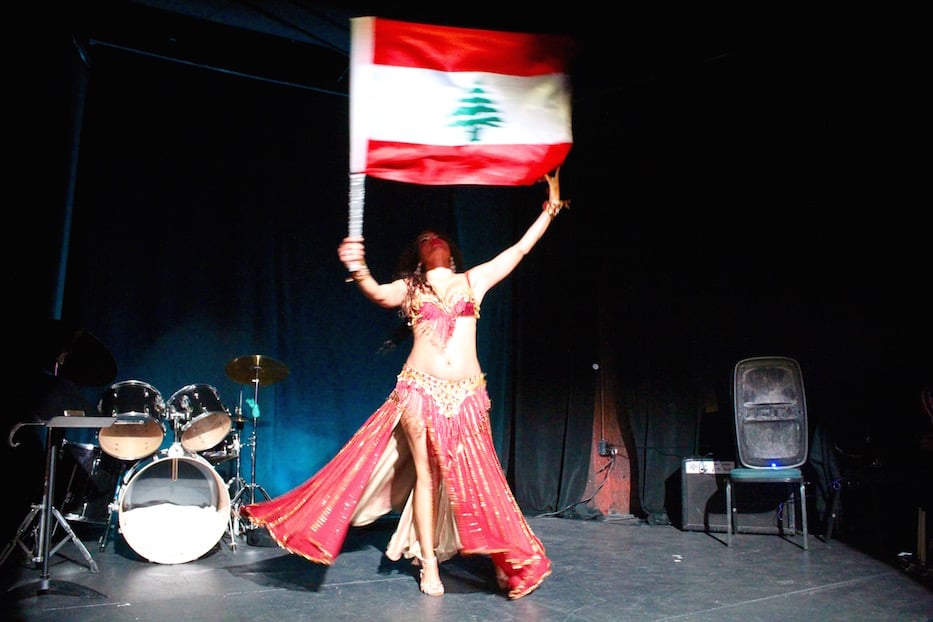
Kelvia Mitri-Meda, who runs the Middle Eastern Dance Academy of Connecticut in West Haven.
Leal, who grew up in Colombia and now lives in New York City, said she saw the arts as a logical entrypoint into a discussion around resistance. During her performance, she yoked propulsive movement, human heartbeats and protest anthems from across the globe and LGBTQ+ rights to her own search for liberation.
Earlier in the day, she helped facilitate a workshop around the Theatre of the Oppressed, a technique from Brazilian theatermaker Agosto Boal that brings together theater, lived experience, and conflict resolution. Leal became involved in the Festival de la Resistencia after Güiza-Chavez saw her perform in New York.
“I realized that people listen to me more when I am performing,” she said. “The arts have that power. That connection with people. I think there are so many ways to continue the fight, but the stage is one of them.”
To learn more about the Semilla Collective, follow them on Facebook or Instagram or at their website..

